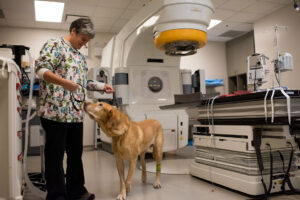NC State Veterinary Medicine Research Roundup, December 2020

A look at some of the latest published research from the CVM.
Feline Infectious Disease Characteristics
A new study suggests there are no pathognomonic thoracic radiographic findings in cats with acute cytauxzoonosis. It is the first published report describing if such signs are associated with the disease.
The retrospective study evaluated 37 cats with confirmed cytauxzoonosis and reviewed the related thoracic radiographic findings. Researchers found that a bronchial pulmonary pattern was the most common finding. Cytauxzoon felis is a tick-borne parasite that often causes fatal disease in domestic cats.
The study is published in Veterinary Radiology & Ultrasound. Authors include Nicholas Petrovitch, Adam Birkenheuer, Megan Schreeg, Tzushan Yang and Ashley Melco.
Read the study here.
Cancer Outcomes in Dogs
It is possible to obtain Cherenkov emissions during radiation therapy in larger human-sized tumors of pet dogs with cancer, information that could improve therapies.
Real-time monitoring of physiological changes of tumor tissue during radiation therapy could improve the therapeutic effectiveness and predict outcomes. Previous studies have confirmed Cherenkov emission spectra as indications of blood-oxygen saturation and water-content changes in tumor tissues, both correlated with patient prognosis.
PLOS One published the study. Authors include Michael Nolan and Hiroto Yoshikawa.
Read the study here.
Behavior of Doxorubicin
New research sheds light on mechanisms related to the chemotherapy medication doxorubicin (DXR).
Among the findings: DXR increases paracellular transit of small macromolecules, including bacterial products, through the epithelium by altering expression of tight junctional components and dynamic loosening of cellular tight junctions.
The data suggest prior findings demonstrating the importance of enteric bacteria in DXR mucositis are likely to do paracellular movement of bacterial pathogen-associated molecular patterns (PAMPs) across the epithelial barrier, resulting in stimulation of cellular receptors on the epithelium and subepithelium.
Scientific Reports published the research. Authors include Christopher Dekaney, Josca Cortes, Breanna Sheahan and Paul Cray.
Read the study here.
Understanding Nairobi Sheep Disease Virus
A new historical and epidemiological review of the Nairobi sheep disease virus (NSDv) offers valuable insight into the zoonotic and tick-borne disease to help control its spread.
The study provides a comprehensive overview of NSDv, which can cause over 90% mortality in small ruminants. It has historically circulated in East Africa and has recently emerged in Asia. Some warmer-climate regions persistently report disease outbreaks despite efforts to control it.
The report covers environmental factors that influence transmission and sheds light on possible emergence in other regions. Data was studied from 308 world locations, including Uganda, India and China, and the results identified areas suitable for NSDv throughout Africa and Asia. Soil moisture, livestock density and precipitation predispose certain areas to NSDv circulation, according to the study.
Frontiers in Veterinary Science published the research. Authors include Gustavo Machado, Alba Frias-De-Diego, Manuel Jara and Stephanie Krasteva.
Read the study here.
Galápagos Gull Health
For the first time, general health parameters for the swallow-tailed gull of the Galápagos have been published, valuable information for comparisons among different populations in the archipelago and to detect changes in health status of the seabirds.
The study outlines general health using blood chemistry and hematology, run on samples drawn from 58 clinically healthy swallow-tailed gulls found at Islote Pitt on San Cristóbal Island and South Plaza Island.
Conservation Physiology published the research. Authors include Greg Lewbart, Diane Deresienski and Ronald Kent Passingham.
Read the study here.
Evaluating Tendon Sutures

Epitendinous placement of skin staples around a canine core superficial digital flexor tendon (SDFT) site improved the biomechanical strength and resistance to gap formation for the repair, but was inferior to the placement of another form of sutures, according to new research.
Research results indicated that while skin staples were successful around the site of SDFT tenorrhaphy, or surgical suture of a divided tendon, epitendinous placement of Silfverskiöld cross-stitch (SXS) suture pattern was superior to the staples approach. Further research is necessary before skin staples are used for tenorrhaphy augmentation in clinical patients, the study notes.
The American Journal of Veterinary Research published the study. Authors include Daniel Duffy and Yi-Jen Chang.
Read the study here.
~Jordan Bartel/NC State Veterinary Medicine


